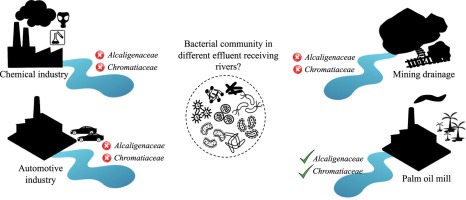Ecological Indicators ( IF 6.9 ) Pub Date : 2020-01-08 , DOI: 10.1016/j.ecolind.2019.106048 Nurhasliza Zolkefli , Norhayati Ramli , Noor Shaidatul Lyana Mohamad-Zainal , Nurul Asyifah Mustapha , Mohd Zulkhairi Mohd Yusoff , Mohd Ali Hassan , Toshinari Maeda

|
Microorganisms are progressively adopted as reliable and specific bioindicators of pollution, with Alcaligenaceae and Chromatiaceae being recently proposed to indicate contamination in river water due to palm oil mill effluent (POME) final discharge. This study was conducted to evaluate the reliability of these bacteria to act as specific bioindicators by assessing their detections in correlation with environmental factors in rivers polluted by POME final discharge when compared to by other pollution sources. By using the Illumina MiSeq high throughput sequencing platform, bacterial diversities and compositions were compared among unpolluted (upstream) river, polluted rivers due to POME final discharge and other rivers polluted by mining, chemical and automotive industries. To correlate between bacterial compositions and metabolisms in rivers subjected to different pollutants sources, the viability and the ratio of the high and low nucleic acids (HNA/LNA) bacterial cells were also compared by using a double staining assay based on flow cytometry. Interestingly, Alcaligenaceae and Chromatiaceae were found only in POME final discharge polluted rivers (>0.15%) but were not detected in rivers polluted by other pollutants. Higher bacterial cell viability was detected in rivers polluted by POME final discharge (86–91%) as compared to the other polluted rivers (15–80%). From the viable fractions of the bacterial cells, higher HNA cells (91–93%) were quantified in the POME final discharge receiving rivers but with only 5–18% in the other rivers. These trends indicated that the nutrients carried by the POME final discharge enhanced the growth of bacteria in the receiving river water that might include Alcaligenaceae and Chromatiaceae. These results suggested that either Alcaligenaceae or Chromatiaceae or both were unique in the POME final discharge polluted rivers but not in the others. They could function as specific and reliable bacterial bioindicators relevant for the establishment of a complementary monitoring system for POME pollutant discharge.
中文翻译:

Alcaligenaceae和Chromatiaceae如棕榈油磨流出物污染的细菌生物指示剂(POME)最终排出污染河流
微生物被逐步采用污染的可靠和具体的生物指示剂,用Alcaligenaceae和Chromatiaceae最近有人提议指出棕榈油厂的废水(POME)的最终排放造成河水污染。进行这项研究是为了评估这些细菌作为特定生物指示剂的可靠性,方法是评估其检测结果与与其他污染源相比受到POME最终排放污染的河流中环境因素的相关性。通过使用Illumina MiSeq高通量测序平台,比较了未污染(上游)河,由于POME最终排放而污染的河以及采矿,化学和汽车工业污染的其他河中细菌的多样性和组成。为了使受到不同污染物污染的河流中的细菌组成与新陈代谢之间具有相关性,通过基于流式细胞术的双重染色测定,还比较了高和低核酸(HNA / LNA)细菌细胞的活力和比率。有趣的是Alcaligenaceae和Chromatiaceae仅发现在最终POME放电污染河流(> 0.15%),但在由其它污染物污染的河流中未检测到。与其他被污染的河流(15-80%)相比,在被POME最终排放物污染的河流(86-91%)中检测到更高的细菌细胞活力。从细菌细胞的存活部分中,较高的HNA细胞(91–93%)在接受POME的最终排放河流中定量,而在其他河流中只有5–18%。这些趋势表明,携带营养物质通过POME最终放电增强细菌在接收河水生长,可能包括Alcaligenaceae和Chromatiaceae。这些结果表明,任君草科或Chromatiaceae或两者在POME最终排放污染河流中是独特的,但在其他河流中则不是。它们可作为特定和可靠的细菌生物指示剂,与建立POME污染物排放的补充监测系统有关。


























 京公网安备 11010802027423号
京公网安备 11010802027423号